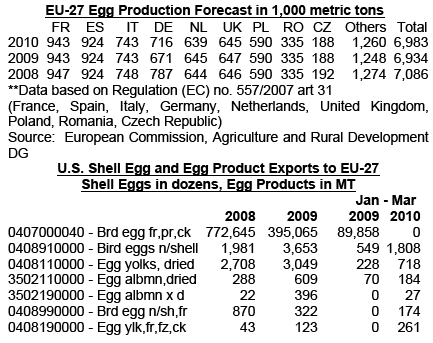



International Egg and Poultry Review: EU
EU - This is a weekly report by the USDA's Agricultural Marketing Service (AMS), looking at international developments concerning the poultry industry. This week's report focuses on the EU-27 broiler welfare and the impacts on US egg exports to the region.The European Union adopted Council Directive 1999/74/EC, setting minimum standards for the protection of laying hens in July 1999. The Directive set minimum standards for laying hens kept in battery cages. It exempts establishments with fewer than 350 laying hens and establishments rearing breeding laying hens.
Provisions for unenriched cage systems went into effect on 1 January 2003 requiring a minimum space of at least 550 square cm per hen per cage, among other requirements, and no new cage systems could be built as of this date. Effective 1 January 2012, keeping laying hens in conventional cages will be prohibited.
A set of requirements was set for alternative systems; from 1 January 2002 all newly built or rebuilt systems brought into use for the first time had to meet these requirements. From 1 January 2007 the minimum requirements applied to all alternative systems.
After 1 January 2002 minimum requirements for enriched cages include at least 750 square cm of cage area per hen, 600 square cm of which shall be usable, and no cage shall have a total area that is less than 2,000 square cm. Additional provisions are made for other details of enriched cages.
Member States are allowed to maintain or apply more stringent provisions. Austria banned the use of conventional cages effective 1 January 2009 and enriched cages will be banned by 2020; Germany required all laying hens to be out of conventional cages by the end of 2009; Sweden phased out conventional cages by the end of 2002.
Source: Official Journal of the European Communities, news wires


US shell egg and egg products exports to the EU expanded sharply in 2009, and continued to expand in the first quarter of 2010. The major destinations were Germany, Denmark and the Netherlands. For the first three months of 2010, exports to Germany grew 103 per cent (from $2.1 million to $4.40 million); Denmark rose 256 per cent (from $623,000 to $2.2 million) and the Netherlands increased ten-fold (from $100,000 to $1.1 million).
Further Reading
| - | You can view the full report by clicking here. |










